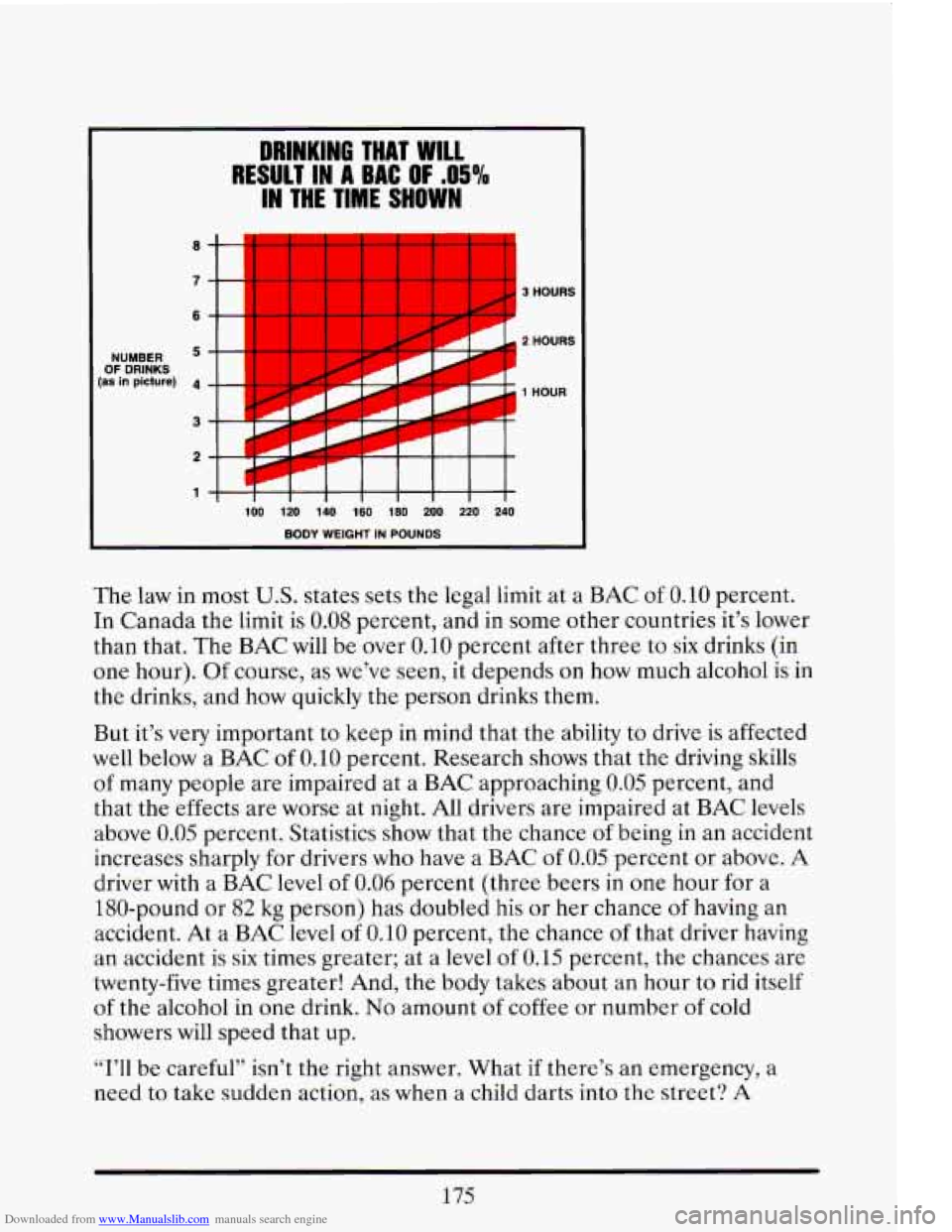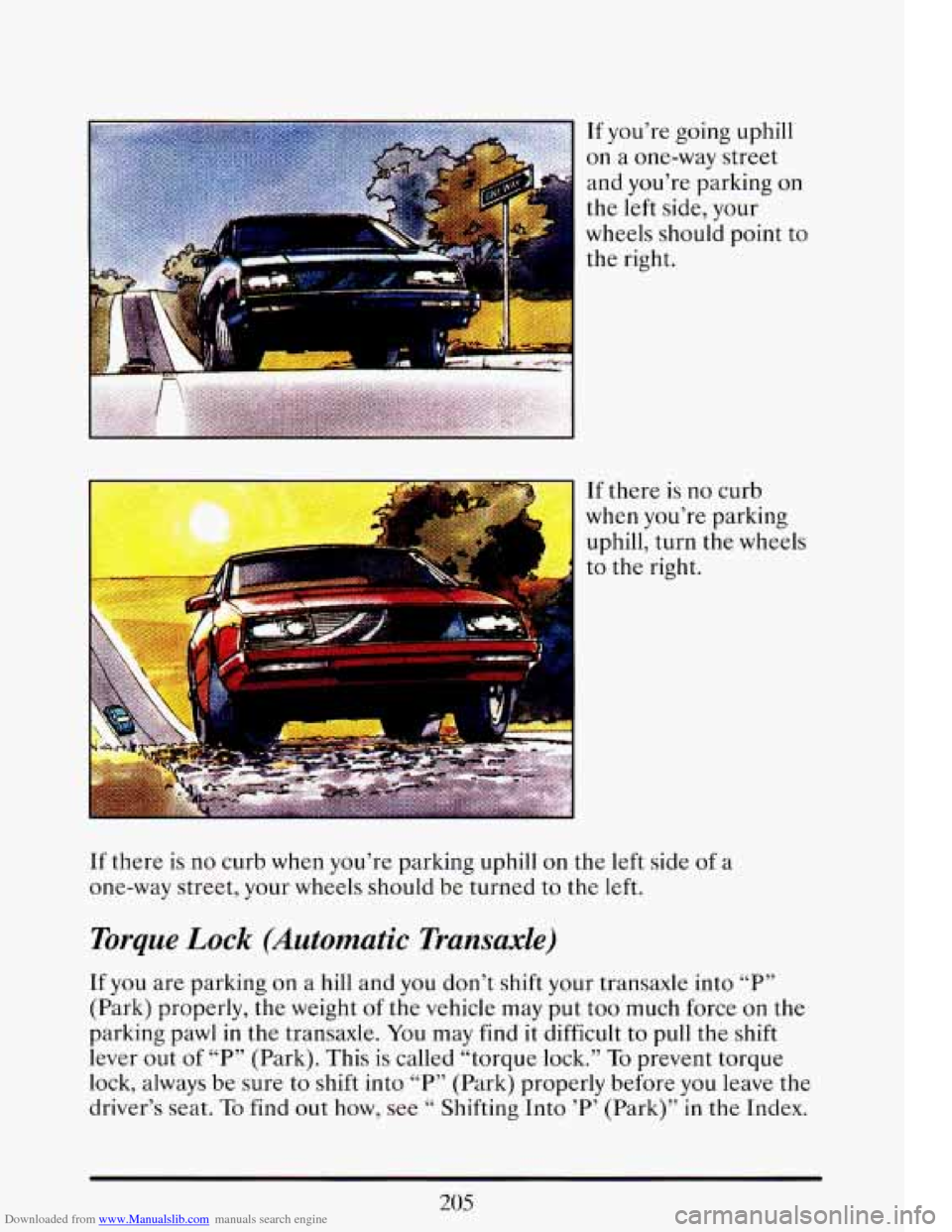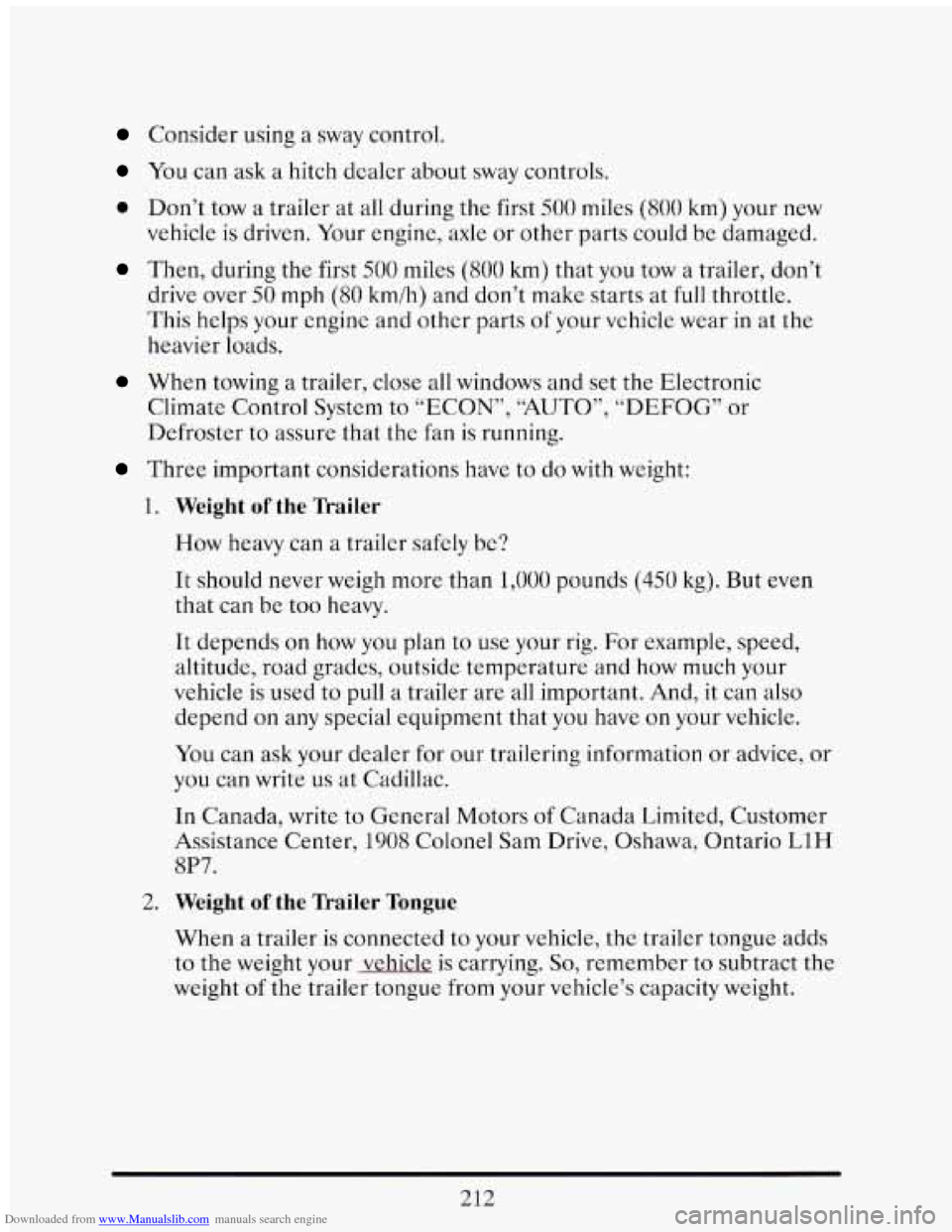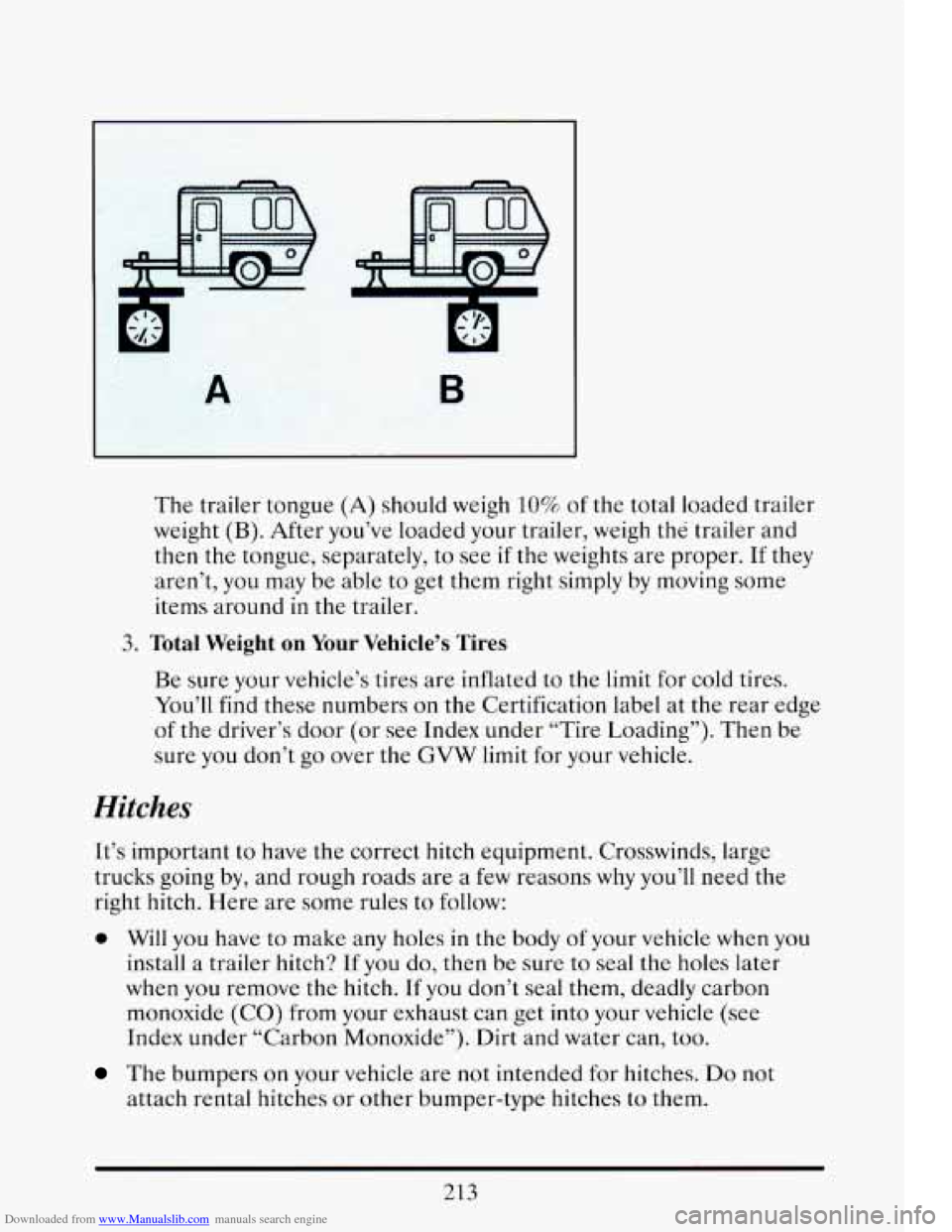1993 CADILLAC ELDORADO weight
[x] Cancel search: weightPage 187 of 398

Downloaded from www.Manualslib.com manuals search engine Here’s a final bit of information about defensive driving. The most
- dangerous time for driving in the U.S. is very early on Sunday morning. In
I fact, GM Research studies show that the most and the least dangerous
times for driving, every week, fall on the same day. That day is Sunday.
7 The most dangerous time is Sunday from 3 a.m. to 4 a.m. The safest time
is Sunday from 10 a.m. to 11 a.m. Driving the same distance on a Sunday
at 3 a.m. isn’t just a little more dangerous than it
is at 10 a.m. It’s about
7 134 times more dangerous!
That leads to the next section.
r- DRUNKEnT DMNG
! Death and injury associated with drinking and driving is a national
tragedy. It’s the number one contributor to the highway death toll,
claiming thousands of victims
every year. Alcohol takes away three things
that anyone needs to drive a vehicle: 7.
-
0 Judgment
Muscular Coordination
Vision
alcohol
- a driver, a passenger or someone else, such as a pedestrian,
had been drinking. In most cases, these deaths are the result of someone
who was drinking and driving. Over
25,000 motor vehicle-related deaths
occur each year because of alcohol, and thousands
of people are injured.
i- Police records show that half of all motor vehicle-related deaths involve r
7
Just how much alcohol is too much if a person plans to drive? Ideally, no
one should drink alcohol and then drive. But
if one does, then what’s “too
much”? It can be a lot less than many might think. Although it d,epends
on each person and situation, here is some general information on the
The Blood Alcohol Content
(BAC) of someone who is drinking depends
upon four things:
r
c problem.
r I.
How much alcohol is in the drink.
0 The drinker’s body weight.
0 The amount of food that is consumed before and during drinking.
The length of time it has taken the drinker to consume the alcohol.
r
173
Page 189 of 398

Downloaded from www.Manualslib.com manuals search engine DRINKING THAT WILL
RESULT IN A BAC OF .O5%
IN THE TIME SHOWN
OF DR!NKS (as In picture) 4
”+
2r 1
IOURS
‘ I 2 HOURS
100 120 140 160 180 200 220 240
BODY WEIGHT IN POUNDS
IOUR
The law in most U.S. states sets the legal limit at a BAC of 0.10 percent.
In Canada the limit
is 0.08 percent, and in some other countries it’s lower
than that. The BAC will be over
0.10 percent after three to six drinks (in
one hour). Of course, as we’ve seen, it depends on
how much alcohol is in
the drinks, and how quickly the person drinks them.
But it’s very important to keep
in mind that the ability to drive is affected
well below a BAC
of 0.10 percent. Research shows that the driving skills
of many people are impaired at a BAC approaching 0.05 percent, and
that the effects are worse at night. All drivers are impaired \
at BAC levels
above
0.05 percent. Statistics show that the chance of being in an accident
increases sharply for drivers who have a BAC of
0.05 percent or above. A
driver with a BAC level of 0.06 percent (three beers in one hour for a
180-pound or 82
kg person) has doubled his or her chance of having an
accident. At a BAC level
of 0.10 percent, the chance of that driver having
an accident is six times greater; at a level of 0.15 percent, the chances are
twenty-five times greater! And, the body takes about an hour to rid itself
of the alcohol
in one drink. No amount of coffee or number of cold
showers
will speed that up.
“I’ll be careful” isn’t the right answer. What if there’s an emergency, a
need to take sudden action,
as when a child darts into the street? A
175
Page 219 of 398

Downloaded from www.Manualslib.com manuals search engine If there is no curb
when you’re parking
uphill, turn the wheels
to the right.
If there
is no curb when you’re parking uphill on the left side of a
one-way street, your wheels should be turned to the left.
Torque Lock (Automatic Transaxle)
If you are parking on a hill and you don’t shift your transaxle into “P”
(Park) properly, the weight of the vehicle may put too much force on the
parking pawl
in the transaxle. You may find it difficult to pull the shift
lever out
of “P” (Park). This is called “torque lock.” To prevent torque
lock, always be sure
to shift into “P” (Park) properly before you leave the
driver’s seat.
To find out how, see “ Shifting Into ’P’ (Park)” in the Index.
205
Page 225 of 398

Downloaded from www.Manualslib.com manuals search engine TOWING A TMLER
’ A CAUTION:
If you don’t use the correct equipment and drive properly, you
can lose control when you pull
a trailer. For example, if the
trailer is too heavy, the brakes may not work well
-- or even at
all. You and your passengers could be seriously injured. Pull a
trailer onp7 ;€you have followed all the step? in this section.
NOTJCE
Fulling
I
in costly repairs not covered by your wan lty. To pull a trailer
correctly, follow the advice
in this secti I.
Load-pulling components such as the engine, transaxle, wheel assemblies,
and tires are forced to
work harder against the drag of the added weight.
The engine is required
to operate at relatively higher speeds and under
greater loads, generating extra heat. What’s more, the traile\
r adds
considerably to wind resistance, increasing the pulling requirements.
All of that means changes in:
0 Handling
0 Durability
Fuel economy
If You Do Decide To Pull A Trailer
If you do, here are some important points.
There are many different laws having to do with trailering. Make sure
your rig will be legal,
not only where you live but also where you’ll be
driving.
A good source for this information can be state or provincial
police.
21 1
Page 226 of 398

Downloaded from www.Manualslib.com manuals search engine Consider using a sway control.
You can ask a hitch dealer about sway controls.
0 Don’t tow a trailer at all during the first 500 miles (800 km) your new
vehicle is driven. Your engine, axle or other parts could be damaged.
Then, during the first 500 miles (800 km) that you tow a trailer, don’t
drive over 50 mph (80 kmih) and don’t make starts at full throttle.
This helps your engine and other parts
of your vehicle wear in at the
heavier loads.
When towing a trailer, close all windows and set the Electronic
Climate Control System
to “ECON”, “AUTO”, “DEFOG” or
Defroster to assure that the fan is running.
Three important considerations have to do with weight:
1. Weight of the nailer
How heavy can a trailer safely be?
It should never weigh more than 1,000 pounds (450 kg). But even
that can be too heavy.
It depends on how you plan to use your rig. For example, speed,
altitude, road grades, outside temperature and how much your
vehicle
is used to pull a trailer are all important. And, it can also
depend on any special equipment that you have on your vehicle.
You can ask your dealer for our trailering information or advice, or
you can write
us at Cadillac.
In Canada, write to General Motors of Canada Limited, Customer
Assistance Center,
1908 Colonel Sam Drive, Oshawa, Ontario L1H
8P7.
2. Weight of the Trailer Tongue
When a trailer is connected to your vehicle, the trailer tongue adds
to the weight your vehicle is carrying.
So, remember to subtract the
weight of the trailer tongue from your vehicle’s capacity weight.
212
Page 227 of 398

Downloaded from www.Manualslib.com manuals search engine The trailer tongue (A) should weigh 10% of the total loaded trailer
weight
(B). After you’ve loaded your trailer, weigh the trailer and
then the tongue, separately, to see
if the weights are proper. If they
aren’t, you may be able to get them right simply
by moving some
items around in the trailer.
3. Total Weight on Your Vehicle’s Tires
Be sure your vehicle’s tires are inflated to the limit for cold tires.
You’ll find these numbers on the Certification label at the rear edge\
of the driver’s door (or see Index under “Tire Loading”). Then be
sure you don’t go over the
GVW limit for your vehicle.
Hitches
It’s important to have the correct hitch equipment. Crosswinds, large
trucks going by, and rough roads are a
few reasons why you’ll need the
right hitch. Here are some rules to follow:
0 Will you have to make any holes in the body of your vehicle when you
install a trailer hitch? If you do, then be sure to seal the holes later
when
you remove the hitch. If you don’t seal them, deadly carbon
monoxide
(CO) from your exhaust can get into your vehicle (see
Index under “Carbon Monoxide”). Dirt and water can, too.
The bumpers on your vehicle are not intended for hitches. Do not
attach rental hitches or other bumper-type hitches to them.
213
Page 228 of 398

Downloaded from www.Manualslib.com manuals search engine Safety Chains
You should always attach chains between your vehicle and your trailer.
Cross the safety chains under the tongue of the trailer
so that the tongue
will not drop to the road
if it becomes separated from the hitch. Follow
the manufacturer’s recommendation for attaching safety chains. \
Always
leave just enough slack
so you can turn with your rig. And, never allow
safety chains
to drag on the ground.
Trailer Brakes
Does your trailer have its own brakes? Be sure to read and follow the
instructions for the trailer brakes
so you’ll be able to install, adjust and
maintain them properly.
Because you have anti-lock brakes, do not try to tap into your vehicle’s
brake system. If you do, both brake systems won’t work well, or at all.
Driving with a Trailer
Towing a trailer requires a certain amount of experience. Before setting
out for the open road, you’ll want
to get to know your rig. Acquaint
yourself with the feel of handling and braking with the added weight
of
the trailer. And always keep in mind that the vehicle you are driving is
now a good deal longer and not nearly so responsive as your vehicle is by
itself.
Before you start, check the trailer hitch and platform, safety chains,
electrical connector, lights, tires and mirror adjustment.
If the trailer has
electric brakes, start your vehicle and trailer moving and then apply the
trailer brake controller
by hand to be sure the brakes are working. This
lets you check your electrical connection at the same time.
During your trip, check occasionally to be sure that the load is secure,
and that the lights and any trailer brakes are
still working.
Following Distance
Stay at least twice as far behind the vehicle ahead as you would when
driving your vehicle without a trailer. This can help
you avoid situations
that require heavy braking and sudden turns.
214
Page 317 of 398

Downloaded from www.Manualslib.com manuals search engine Once you have
replaced
the air
cleaner filter, reverse the steps to reassemble and install back into
your vehicle.
LOADING YOUR VEHICLE
OCCUPANTS VEHICLE
CAP. WT.
TIRE-LOADING
INFORMATION
FRT. CTR.
RR. TOTAL LBS. KG
MAX. LOADING
& GVWR SAME AS VEHICLE
CAPACITY WEIGHT XXX COLD TIRE
TIRE
SIZE SPEED PRESSURE
RTG
PS VKPa
FRT.
RR.
SPA.
IF TIRES ARE HOT. ADD 4PSV28KPa SEE
OWNER'S MANUAL FOR ADDITIONAL
GEN GME \INFORMATION
Two labels on your vehiclc show how much weight it may properly carry.
The Tire-Loading Information label found on the driver's door tells you
the proper size, speed rating and recommended inflation pressures for
the tires on your vehicle.
It also gives you important information about
the number of people that can be in your vehicle and thc total weight that
303